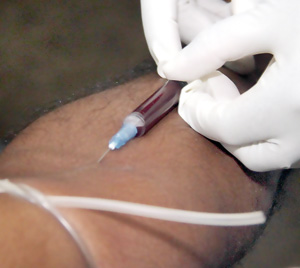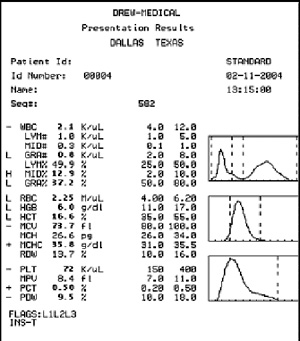Common tests: What you need to know
View(s):
Just a little pricking pain at the site. Pic by Indika Handuwala
This month we kick off a new series in MediScene about the most common diagnostic tests. With Prof. Shyam Fernando, a consultant physician and Professor in Medicine as our guide we’ll explore what exactly each test entails, how it is applied and what role it plays in allowing the doctor to reach a diagnosis. We’ll also talk about your role: how you can prepare, what after-effects you can plan for and at which points you need to take special care.
We begin with a focus on blood tests, specifically on a full blood count (FBC) or a complete blood count (CBC). Blood tests are so common, everyone has had one. Here’s what you need to know:
What it is:
A full blood count provides detailed information about three types of cells in your blood: red blood cells, white blood cells and platelets.They are made in the bone marrow in the breast bone, ribs, backbone and pelvis, where spongy tissue sits at the cavity of your bones. Each cell plays an important role in your body’s normal function from facilitating the transport of oxygen and waste to defending the body against infectious disease.
Red blood cells carry oxygen from your lungs to tissues.
White blood cells help protect from infections. There are different types of white blood cells which perform different functions.
Platelets are the smallest blood cells. They are required to plug off bleeding after a cut or a bruise. Medications such as aspirin prescribed after heart attacks, are given to reduce the stickiness of these platelets and prevent clogging of arteries.

Blood count report
How is it done:
A technician or a nurse will prick a vein on your arm and take about 2ml of blood into a special bottle. You need not fast for the test. It can be done at any time.
In most modern laboratories blood cells are counted using automated counters.
How is it used in diagnosis?
‘Hb’ indicates the level of haemoglobin in blood. If it is low, doctors will know you are anaemic. There are other numbers such as ‘MCV’, ‘MCHC’ & ‘MCH’. By looking at these, doctors can say what type of anaemia it is, for example whether it is due to lack of iron or vitamin B. ‘HCT’ (or haematocrit, pronounced ‘he-mato-krit’) indicate whether blood is concentrated or not. When managing patients with dengue, a rising HCT tells us that fluid is leaking out of circulation. In those, particularly in overweight people, who smoke and drink alcohol excessively Hb & HCT might be high. They have a higher than normal haemoglobin level in blood.
ust like too much of vehicles on the road slowing down traffic, blood circulation can get clogged when this happens and might end up in heart attacks or strokes.
White cell count is shown as WBC or WCC on the report. There are different types of white cells such as neutrophils, lymphocytes, eosinophils. These are counted separately and are indicated on the report. In case of bacterial infections, WCC, particularly the neutrophil count rises. This is therefore useful to detect bacterial infections. In viral infections and in some patients taking certain kind of medications, neutrophil count will be low. High eosinophil counts may occur in filarial, worm infestations or in certain allergic conditions. Unusually high WBC counts are seen in certain types of leukaemia. Usually, on the report, normal numbers for different blood cell counts are given. If your cell count is slightly beyond these you need not worry, as unlike factory-made robots, we don’t have the same measurements!
Platelet count (PC) can vary between150,000 – 400,000 cumm. Many of you are aware that PC can fall in severe dengue infection. The danger is spontaneous bleeding if this falls too far down. There are many other conditions, for example bone marrow problems, where platelet count might be low.
How do I prepare?
No fasting is needed beyond an appointment with the lab.
What are the after-effects?
There are no after-effects. Just a little pricking pain at the site.
What are the pitfalls?
FBC (or CBC) should not be interpreted alone, without taking into consideration the patient’s clinical history, examination findings and the reasons why it was requested. One has to keep in mind that tests (blood tests, X-rays etc) are only the third step in the process of making a diagnosis: the first step being the clinical history, and the second, examination findings. There may be slight variations beyond the normal range given on the report, which may be judiciously ignored by an experienced doctor.


